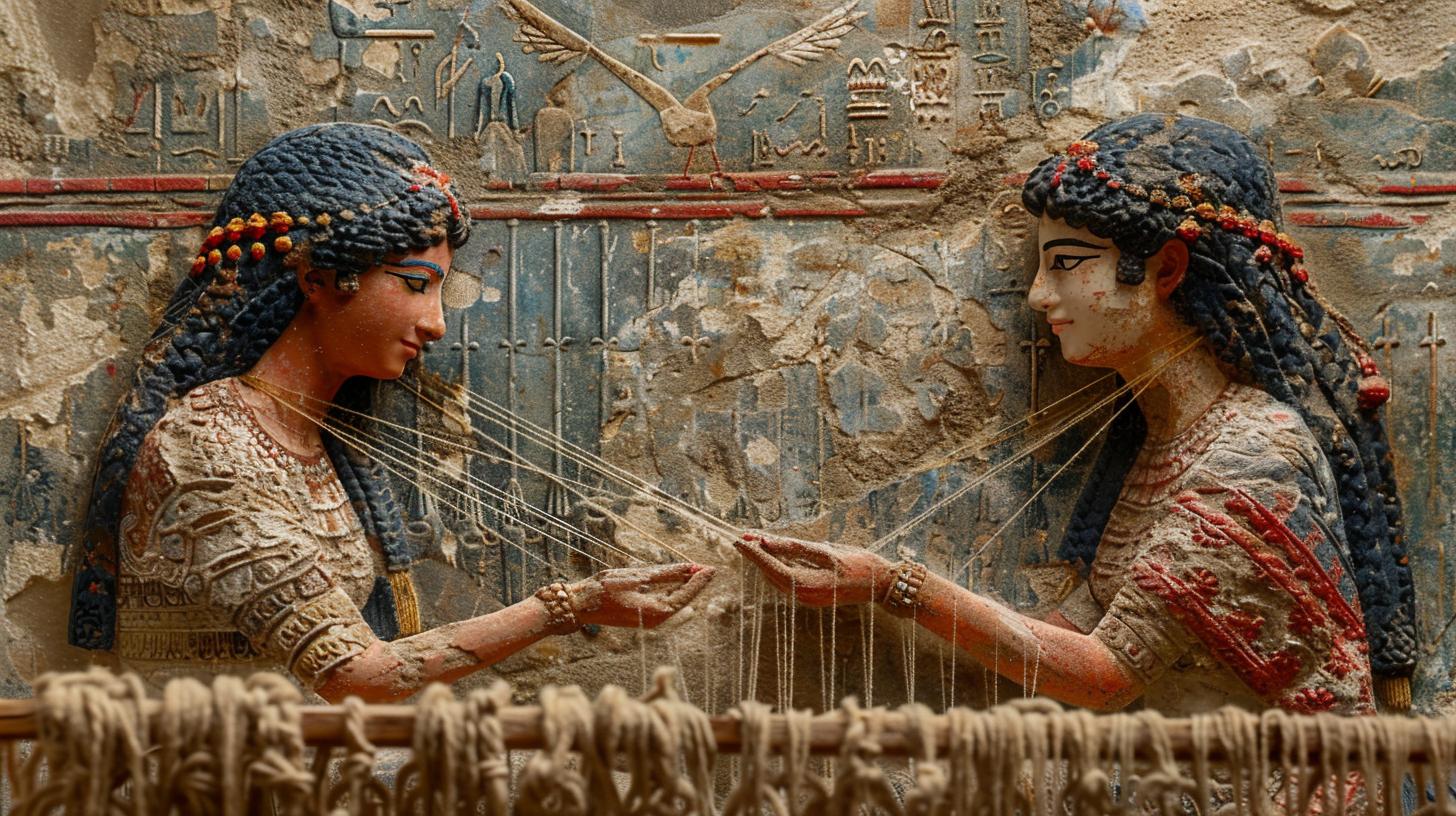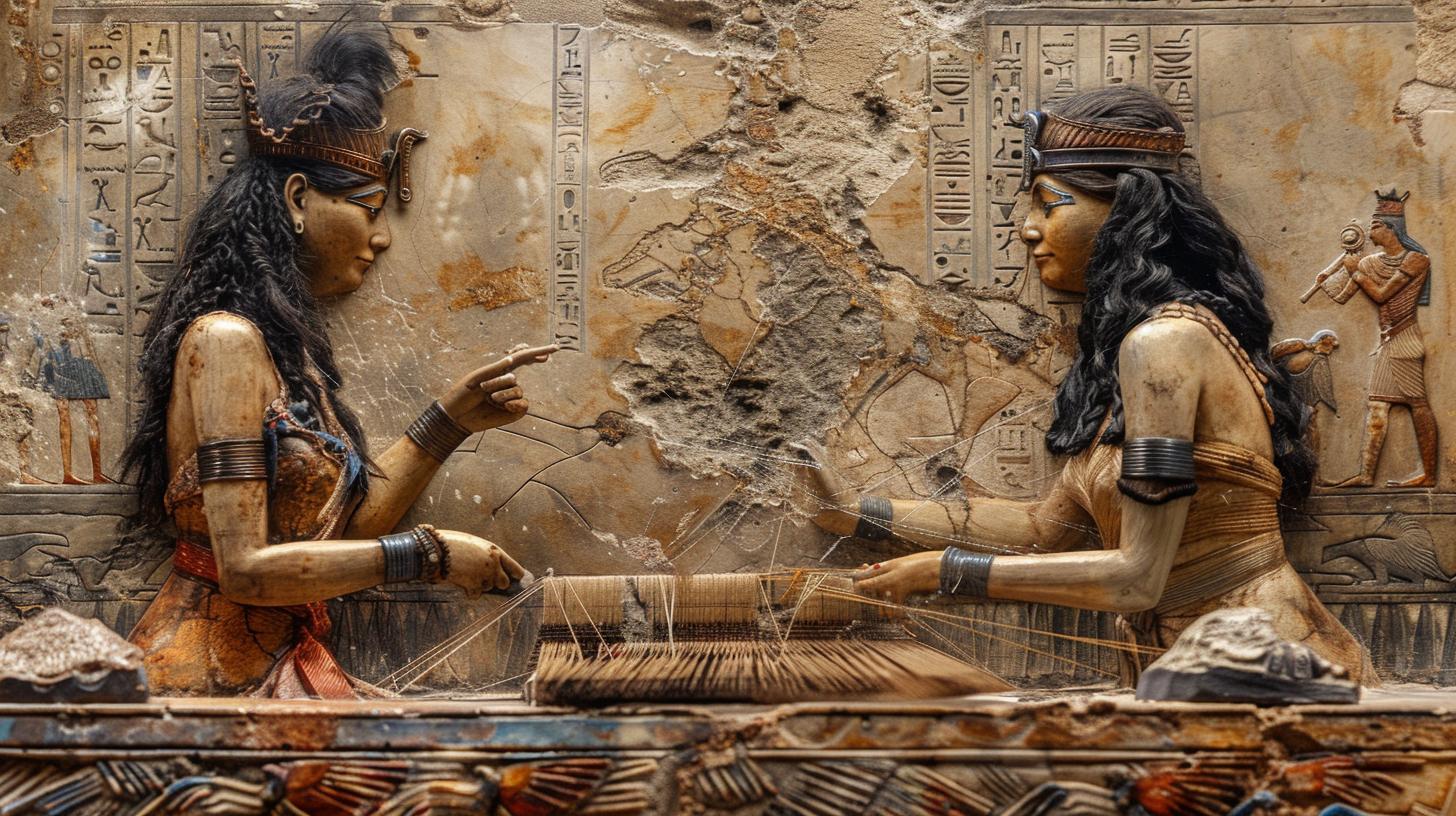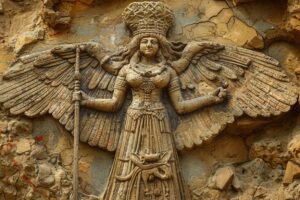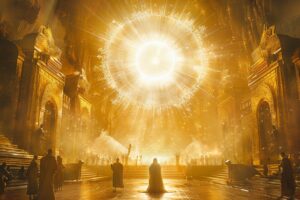Istustaya and Papaya: Exploring Their Roles and Symbolism in Hittite Mythology

Istustaya and Papaya are deities from the Hittite mythology, originating from Hattian beliefs. They play crucial roles as goddesses of fate, weaving the threads that determine human lives, especially that of the king.
Their roles and symbolism are essential in understanding Hittite culture and religion. They are often compared to similar figures in other mythologies, such as the Greek Moiras and Norse Nornir.
Origins and Historical Context
Understanding the origins and historical context of Istustaya and Papaya involves exploring the Hittite civilization and the influences of Hattian deities.
The Hittite Civilization
Definition and Timeline
The Hittite civilization emerged in Anatolia around the 18th century BCE and became one of the significant powers in the ancient Near East. The Hittites are known for their advanced legal structures, military prowess, and diplomatic relations with surrounding cultures.
The height of Hittite power was during the 14th and 13th centuries BCE, under the reign of powerful kings such as Suppiluliuma I and Muwatalli II. Their empire declined around 1200 BCE due to internal strife and external pressures, including invasions by the Sea Peoples.
Cultural Influences
The Hittites were heavily influenced by the cultures surrounding them, including Mesopotamian, Hurrian, and Hattian peoples. This amalgamation of cultures is evident in their religion, language, and art. They adopted and adapted various deities and religious practices from these cultures, which played a role in shaping their unique religious landscape.
Hattian Deities in Hittite Mythology
Integration of Istustaya and Papaya
Istustaya and Papaya, originally Hattian deities, were incorporated into Hittite mythology as goddesses of fate. Their integration reflects the Hittites’ tendency to syncretize deities from different cultures under their dominion.
This practice helped in unifying their diverse empire through shared religious beliefs.
These goddesses held significant roles in the Hittite religion, particularly in the context of the king’s destiny, which was believed to be intertwined with the fate of the entire kingdom.
The Ancient Middle East and Religious Syncretism
Beliefs about Fate and Destiny
The ancient Middle Eastern cultures, including the Hittites, shared a profound belief in fate and destiny. These beliefs were often personified through deities who controlled the threads of life and determined human destinies.
Istustaya and Papaya, as fate goddesses, were crucial in this context.
Religious syncretism was a common practice, where elements of different religious traditions were merged. This is seen in the integration of Hattian deities into the Hittite pantheon and the adoption of Mesopotamian and Hurrian deities and practices.
Fate and destiny were seen as preordained and unchangeable, and deities like Istustaya and Papaya were central to rituals and myths that aimed to understand and influence these cosmic forces.
Roles and Functions of Istustaya and Papaya
Istustaya and Papaya hold significant roles in Hittite mythology, primarily related to the destiny of humans and the king.
The Task of Hilar the Hilo of Life
The primary role of Istustaya and Papaya is to weave the hilo (thread) of life, which determines the destiny of individuals, particularly the king.
Symbolism of the Hilo
The hilo symbolizes life itself, representing the continuity and threads of existence from birth to death. Weaving the hilo was not merely a physical act but a metaphor for control over human lives.
This task underscored the divine power to shape one’s destiny.
The King’s Fate
The king’s hilo was especially significant. In Hittite culture, the prosperity and fate of the king were directly linked to the welfare of the kingdom. The king’s hilo was believed to be intricately woven with care and divine attention, reflecting his central role in society.
Comparisons with Other Fate Goddesses
Istustaya and Papaya’s roles are paralleled by similar entities in other mythologies, signifying a universal archetype related to fate.
Moiras of Greek Mythology
In Greek mythology, the Moiras, or Fates, are three sisters who control the threads of life. Clotho spins the thread, Lachesis measures it, and Atropos cuts it. This trio performs functions similar to Istustaya and Papaya, highlighting a common mythological theme of destiny control.
Nornas of Norse Mythology
The Nornas in Norse mythology, composed of Urd, Verdandi, and Skuld, are also weavers of fate. They spin, weave, and cut the threads of lives at the roots of Yggdrasil, the World Tree.
This demonstrates another cultural representation of fate goddesses who influence destiny through the metaphor of weaving.
Symbolism and Rituals
The symbolism and rituals associated with Istustaya and Papaya are central to their worship and cultural significance in Hittite mythology. These elements reflect the deep beliefs about fate and destiny.
Key Symbols Associated with Istustaya
Hilo
The hilo, or thread, is the most significant symbol connected to Istustaya and Papaya. It represents the thread of life that these deities weave, dictating the destiny of individuals. The act of weaving by these goddesses symbolizes the creation and control over human existence.
Specifically, the king’s hilo held great importance as his fate was linked to the well-being of the entire kingdom.
Espejos
Mirrors are another important symbol in the rituals and practices associated with Istustaya. In various ceremonies, mirrors were utilized as tools for divination. The reflective surface of the mirror, when combined with other ritual elements like oils and candles, was believed to reveal insights into the future and the will of the divine.
Circles
Circles represent the cyclical nature of life and destiny. Rituals often involved circular dances or arrangements to symbolize eternity and the unbroken cycle of creation, life, and death. The use of circles in rituals underscored the continuous influence of Istustaya and Papaya over human fate.
Modern Rituals and Influences
Derviches Giradores
The spinning dance of the Derviches Giradores, also known as the Mevlana, is a modern practice that reflects historical rituals associated with Istustaya and Papaya. This dance is intended to achieve a spiritual unity with the divine.
The participants’ spinning motion signifies the cosmic dance of creation and the eternal flow of life, echoing the ancient rituals dedicated to these goddesses of fate.
Tools for Divination
Contemporary spiritual practices that honor Istustaya involve various tools for divination. Common methods include using mirrors combined with candles and oils to discern visions. Practitioners might also use dream guides or symbolic books to interpret meanings seen in the reflective surfaces.
These rituals aim to connect with the deeper elements of destiny and seek guidance from these ancient deities in modern times.
Istustaya and Papaya in Myths and Legends
Istustaya and Papaya are central figures in Hittite myths and legends, influencing key narratives and the fate of rulers.
The Legend of Telipinu
One of the prominent myths featuring Istustaya and Papaya is the legend of Telipinu. Telipinu, the Hittite god of agriculture and fertility, vanished one day, causing chaos as the earth became barren.
The gods were distressed by his disappearance and sought ways to bring him back.
In this myth, Istustaya and Papaya are called upon due to their powerful roles in determining destinies.
Their involvement underscores their critical status within Hittite mythology, particularly concerning themes of restoration and balance.
Role in the Conference of the Gods
When Telipinu finally returns, a significant event known as the Conference of the Gods takes place. This gathering marks the restoration of order. Istustaya and Papaya participate prominently in this assembly.
Their role in the conference signifies their importance in the divine hierarchy and their influence over cosmic events.
Their presence at the conference highlights the interconnectedness of fate, fertility, and divine order in Hittite mythology.
Their ability to weave the destinies of gods and humans alike places them at the center of this crucial mythological narrative.
Influence on Hittite King Myths
The myths surrounding Hittite kings often prominently feature Istustaya and Papaya. These deities hold the king’s fate in their hands, reflecting their broader role in determining the destiny of the Hittite civilization.
The king’s fate is not only a personal matter but is also seen as intrinsically tied to the fate of the entire kingdom. As such, these goddesses’ actions and decisions have far-reaching implications.
Importance of the King’s Hilo
The concept of the hilo of life is a recurring motif in myths about Hittite kings. Istustaya and Papaya weave this hilo, which symbolizes the king’s life and destiny. The hilo’s importance is paramount; a well-woven hilo promises prosperity and stability, while a thread faltering signals potential danger and disorder.
In these myths, the welfare of the king, and by extension his kingdom, hinges on the meticulous care that Istustaya and Papaya put into their weaving. This symbolism underlines their dual role as protectors and overseers of fate, ensuring the balance and continuity of the Hittite realm.
Modern Reception and Cultural Impact
The influence of Istustaya and Papaya can be seen in modern spiritual and academic circles. Their enduring legacy showcases a blend of ancient beliefs and contemporary interpretations.
Continued Relevance in Spiritual Circles
Influence on Modern Pagans
Istustaya and Papaya have found a place in modern pagan practices. Many contemporary pagans draw on their mythologies to understand fate and life’s journey. These deities are invoked in rituals aimed at divination and understanding life’s path.
Their roles as spinners of destiny are particularly significant. Modern practitioners often meditate on these figures to gain insight into their own lives. The symbolic act of spinning or weaving is recreated in various spiritual activities, symbolizing the control and understanding of personal fate.
Current Practices Reflecting Ancient Beliefs
Modern rituals inspired by Istustaya and Papaya often include symbolic elements used in ancient times. These practices emphasize the continuity of life and destiny from ancient to modern spirituality.
- Rituals involving spinning and weaving
- Meditative practices using mirrors and circles
- Divination techniques with reflective surfaces and oil
The Dervish Whirling, or Mevlana, also holds elements reminiscent of Istustaya’s influence.
This dance aims to achieve unity with the divine, reflecting ancient rituals where such unity was sought through similar movements and symbolic objects.
Academic Perspectives
‘Die hethitische Literatur’ by Volkert Haas
One of the foremost academic works that delves into Istustaya and Papaya is Volkert Haas’s ‘Die hethitische Literatur’. This book provides an in-depth analysis of Hittite literature, dedicating several pages to these deities.
The text explores their roles, myths, and integration into Hittite society, offering valuable insights for scholars and enthusiasts.
Haas’s work is essential for understanding the academic perspective on how these deities shaped and were shaped by Hittite beliefs and practices. The detailed analysis helps in appreciating the complexity and cultural significance of Istustaya and Papaya.
Contemporary Research
Modern research continues to highlight the relevance of Istustaya and Papaya. Academic conferences and journals often feature papers on their impact on ancient and modern spiritual practices. The exploration of their roles in mythology provides a deeper understanding of ancient Hittite religion.
Present-day scholars often compare these deities with similar figures from other mythologies, further elucidating their universal themes. The ongoing research underscores the importance of their contributions to our understanding of fate and destiny across different cultures.
Intersection with Other Cultures
Istustaya and Papaya share similarities with deities of fate from various cultures, reflecting a universal archetype of destiny.
Shared Archetypes in Fate Deities
The concept of deities controlling fate is not unique to the Hittites. Many ancient cultures personified destiny through similar deities who weave the lives of humans.
Universal Representation of Destiny
Across numerous ancient cultures, the role of fate deities remains consistent. These figures weave or manipulate the threads of life, maintaining control over the destiny of all beings:
- Greek Moiras: The Moiras, known as the Fates, consist of three sisters who control the birth, life, and death of every mortal through the spinning, measuring, and cutting of the thread of life.
- Norse Nornir: The Nornir in Norse mythology play a similar role, weaving the destinies of gods and men alike, dwelling by the well of Urd beneath Yggdrasil, the world tree.
Cultural Exchange in the Ancient Middle East
The Hittites were part of a vibrant and interconnected ancient world, which facilitated the exchange of religious and cultural ideas.
How Hittite Culture Influenced Neighboring Civilizations
The interaction between the Hittites and neighboring cultures led to significant cultural syncretism:
- Religious Syncretism: The Hittite pantheon incorporated various deities from neighboring regions, leading to a complex tapestry of beliefs that included elements from Hattian and Hurrian origins.
- Trade and Diplomacy: Extensive trade networks and diplomatic relations facilitated the exchange of not only goods but also ideas, including religious practices and mythologies.
This blending of beliefs underscores the interconnectedness of ancient cultures and the shared human pursuit to understand destiny and existence.





















